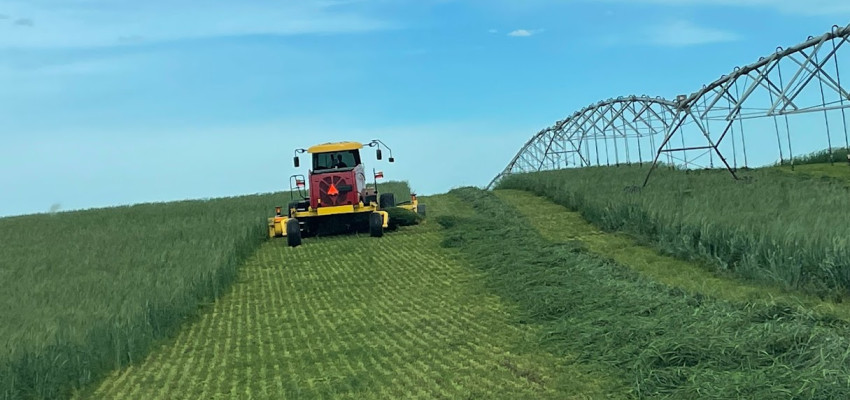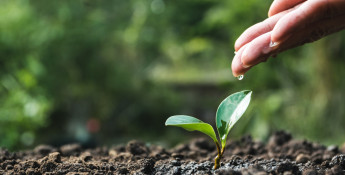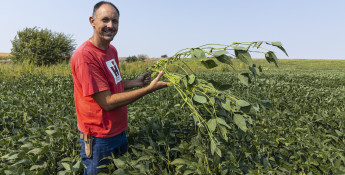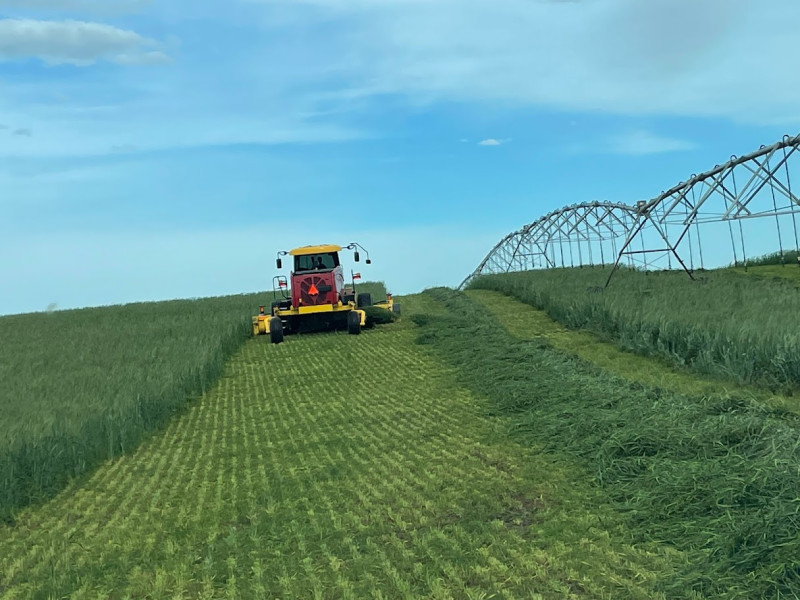By Greg Doering on May 5, 2024
Kansas makes Historic Investment in Preserving the Ogallala Aquifer

An appropriation of $35 million by the Kansas Legislature in 2023 was supported by several agricultural groups, including Kansas Farm Bureau (KFB). This was arguably the most significant investment in the state’s water resources in history. Prior funding for municipal, industrial and agricultural projects was supposed to total $8 million per year, but funding routinely fell short of that amount.
The extra funding comes at a critical time when declining groundwater supplies and diminished surface water storage threaten not just the farmers and ranchers who make up the backbone of the Kansas economy, but also dozens of communities who could have to invest millions in treatment facilities because of worsening water quality and more government regulation.
Legislators also added reporting requirements for each of Kansas’ five groundwater management districts (GMDs) and will require them to identify priority areas within their assigned geographies and develop plans to conserve water there.
Without intervention, the wells that sustain production agriculture in western Kansas will face problems with quality, quantity or both. Some wells have already been decommissioned because the level of the aquifer has receded or the water left isn’t suitable for growing crops. Others have less than a generation of usable water remaining under current demand. The stakes for finding solutions are high.
It’s highly likely the cream in your morning coffee, bacon on your club sandwich at lunch and your steak dinner all contain water from the aquifer. The Ogallala Aquifer supports 20 percent of the wheat, corn and cattle produced in the U.S. In Kansas, the groundwater is used to raise corn and forage that supports the dairy, pork and beef industries.
Slightly larger than California, the aquifer covers portions of eight states from South Dakota to Texas. In western Kansas, the average yearly rainfall ranges from 15 to 20 inches. That’s enough to grow some grains and forages, but not at the scale it’s done without assistance of on-demand watering from giant sprinklers called center pivots whose rotations create a patchwork of green crop circles.
First in Time
Under the Kansas Water Appropriation Act, all water in the state belongs to the people of the state, but it’s distributed by real property rights for beneficial purposes. In other words, water is a public good, and the state allows groups, both public and private, to use the water for any activity deemed beneficial.
For instance, an individual can apply for a permit to develop a well for irrigation — called an appropriation right — that creates a right to use the water but falls short of conveying ownership of the water.
The property right to use Kansas water is based on the principle of “first in time, first in right.” That means the earliest water right or permit holders have first rights to use the water, especially during a shortage. In theory, this seniority-based system was designed to distribute the available water supply in the event of a shortage. In practice, the state granted too many Ogallala permits with allocations too high for the amount of groundwater recharge available.
In the Spotlight
The legislative effort in 2023 finally put water at the forefront of discussions about how to best manage all sources of water, but especially groundwater in places like GMD 1, which covers portions of Greeley, Lane, Scott, Wallace and Wichita counties.
“Water in Kansas is obviously imperative to our economic health,” says Katie Durham, GMD 1 manager. “The (legislation) was a new precedent for shining a much-needed light on the importance of using water in a responsible manner.”
Durham says GMD 1 has been focused on prolonging the life of the Ogallala Aquifer with locally developed solutions that are farmer-driven and tailored to individual regions based on the health of the aquifer. The additional funding provided by the legislature will help with cost-share programs that encourage farmers to adopt more efficient practices or grow less water-intensive crops.
“We try not to limit it,” she says. “There’s so much new technology out there, you don’t want to limit someone from trying something out.”
She also welcomes the added reporting requirements for all GMDs.
“Farmers are great stewards of the land, so more opportunities to show that is great,” Durham says.
Slowing the Decline
Local enhanced management areas (LEMAs) allow GMDs to set conservation goals within a clearly defined geographic area with monitoring and enforcement elements. The areas give consideration to irrigators who’ve already reduced their usage.
While not the first district to implement a LEMA, Durham says the first one in Wichita County was so successful the other four counties in GMD 1 pursued a similar plan. The Wichita County LEMA was created in 2020 with the goal of reducing irrigation water use by 25 percent, which it has exceeded to date with estimated reductions of nearly 40 percent compared to historical use within the LEMA’s boundaries.
Durham says Wichita County farmers created the LEMA based on dropping water levels in their wells.
“When you see the water disappearing you start considering, ‘Is this going to be worth anything in the future if I don’t do something now?’” she says. “Our goal is to extend the life of the aquifer. If there are areas where we can meet sustainable criteria in an economically sound way, that’s wonderful. We recognize we have to take incremental steps.”
Irrigators and organizations like KFB have been supportive of LEMAs but wary of how they’ve been implemented because they don’t apply evenly to all water users and reductions don’t follow the longtime standard of “first in time, first in right.” Under the plans, which aren’t voluntary, users with senior rights can face larger water use reductions than junior rights-holders. LEMAs require the approval of GMD boards and last for five years, after which they can be renewed or discontinued.
Water is Everything
Just southwest of Garden City in the sandy soils of the Arkansas River Valley, siblings Marc and Gina Gigot have voluntarily placed more than 14 square miles of irrigated land into a water conservation area, which is similar to a LEMA but offers
more flexibility and requires less red tape to establish. Their farm, Circle Land and Cattle, is named after the distinctive rings created by the dozens of center pivots that dot the landscape.
“Everything here has to do with water,” Gina says. “If it goes away, so does Southwest Kansas.”
The Gigot’s voluntary conservation efforts started in 2018 and have reduced pumping from 800 to 1,000 gallons per minute (GPM) down to 300 to 500 GPM. Overall, they’ve reduced their water use by 22 percent based on historical usage. To do that, they’ve employed technology, to a point, but the bulk of the reduction has come from how the farm is managed.
“We’ve changed the dynamics of what was done in the past,” Marc says. “We’re almost 100 percent forage. We’re not growing grain crops. We’re a large farm. It needs to begin with us. We’re hoping others will follow.”
Instead of corn, the Gigots now grow forage like alfalfa, triticale and sorghum that’s chopped for silage and goes to nearby feedlots, including their own, and area dairies.
“We try to walk everything off this farm through cattle,” Marc says. “So far, it’s working. Can you make more money with other crops? Probably in the short term. We’re in it for the long haul."
The changes are already showing promise, with Gina noting water levels are increasing most years or staying the same.
Full Circle
In the near future, the Gigots will reduce their use of groundwater even more by reusing water from Garden City’s water treatment plant over roughly three square miles of their farm. The water comes from the city’s municipal sewer system as well as wastewater from an ethanol plant and a facility that primarily produces powdered milk. The treated water will be piped from just east of the city to Circle Land and Cattle.
“The whole goal for that is seven of the city’s (water) wells are in the pasture east of us,” Gina says. “If we can increase the aquifer over here, then it will benefit the city by increasing the health of their wells.”
The project will reuse about 3,000-acre feet of water, the equivalent of submerging about the same number of football fields in 12 inches of water. It will grow the forage to be fed to dairy cows whose milk production will be powered with the excess water potentially returning to the Gigots farm to start the cycle over again.
The Water Plan
Fully funding the state’s water plan will provide more research to discover less thirsty varieties of existing crops, education on how management decisions can lower water use while maintaining or increasing profitability, and resources to help farmers adopt already available efficiency technologies.
These changes are meant to, at the very least, prolong the life of the Ogallala Aquifer, with the ultimate goal of reaching a point of stability where the aquifer stops declining while farmers are still able to irrigate their crops and help drive Kansas’ economy.
The depletion of the state’s groundwater resources didn’t begin overnight, and solving the problem won’t happen quickly, either. With a spotlight now on the issue and the money to implement changes, Kansas has started on a path toward stability.





